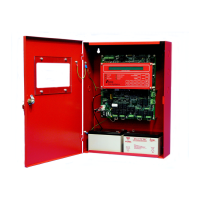P/N 06-236530-001 3-125 August 2013
3-3.1 Communications
Each networked control unit can communicate with every other control unit in the
network. Control unit communication is peer-to-peer via a token-passing protocol. This
method ensures that only one control unit is broadcasting at any one time. Network
Interface Cards (NICs) integrate two or more control units in a networked configuration.
Networked control units are interconnected using shielded, twisted-wire pair, fiber-optic
medium, or mixed transmission media (combination fiber optic or twisted wire pair
media). Each NIC regenerates the network communications, and enables control units to
be up to 4,000 feet apart when using shielded, twisted-wire pair, and up to 1 mile (5,280
feet) when using a 62.5/125 m duplex fiber-optic medium.
Network messages and broadcasts are transmitted over either single- or dual-channel
communications connections. Dual-channel connections offer a redundant
communications path that allows network broadcasting and inter-control-unit
functionality with an open- or short-circuit fault or ground fault on one of the channels.
Any fault in either a single- or dual-channel communications channel creates a network
trouble condition.
3-3.2 Network Event Broadcasts
Each networked control unit can be configured to broadcast any event associated with its
initiating devices or monitored output circuits:
• Locally to the control unit-of-origin only
• Selectively to a subset of networked control units
• Globally to every control unit within the network.
Network broadcasts extend to all ancillary equipment such as Remote Display Control
Modules (RDCMs) and Annunciator Terminal Modules (ATMs) associated with a
designated subset of control units when selective event broadcasting is chosen. Network
broadcasts extend to all such equipment associated with every control unit when the
network is configured for global-event broadcasting.
The default operation for event broadcast is globally to all control units in the network.
3-3.3 Operator Control
Operators can acknowledge events, silence notification appliances, and perform resets in
three different configurations:
• Locally to the control unit-of-origin only
• Selectively to a subset of the networked control units
• Globally to all control units in the network.
Operator-intervention capability extends to all ancillary equipment such as Remote
Display Control Modules (RDCMs) and Annunciator Terminal Modules (ATMs) associated
with a designated subset of control units when selective operator control is used. It
extends to all such equipment associated with every control unit when the network is
configured for global operator control.
3-3.4 Event Recording
Each control unit is configurable to record and display events as follows:
• Locally from its directly-monitored peripheral devices and output circuits only
• Selectively from a subset of networked control units
• Globally from all control units in the network
The default operation for event recording and display is globally from all control units in
the network.

